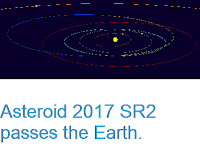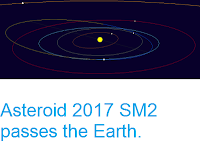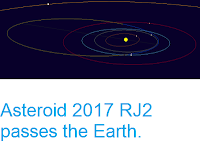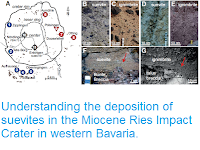Asteroid 2017 SN2 passed by the Earth at a distance of about 8 460 000
km (21.6 times the average distance between the Earth and the Moon, or 5.66% of the distance between the Earth and the Sun), slightly before 3.00
am
GMT on Saturday 23 September 2017. There was no danger of
the asteroid hitting us, though were it to do so it would have
presented a significant threat. 2017 SN2 has an estimated
equivalent
diameter of 110-340 m (i.e. it is estimated that a spherical object
with
the same volume would be 110-340 m in diameter), and an object of this
size would be predicted to be capable of
passing through the Earth's
atmosphere relatively intact, impacting the ground directly with an
explosion that would be 3500-100 000 times as powerful as the
Hiroshima
bomb. Such an impact would result in an impact crater about 1.5-5 km in
diameter
and devastation on a global scale, as well as climatic effects that
would last decades or even centuries.
The calculated orbit of 2017 SN2. Minor Planet Center.
2017 SN2 was discovered on 17 September 2017 (six days before its closest approach to the Earth) by the Atlas MLO Telescope at Mauna Loa Observatory in Hawaii. The designation 2017 SN2
implies that the asteroid was the 63rd object (object N2) discovered in the second half of September 2017 (period 2017 S).
2017 SN2 has an 1086 day orbital period and an eccentric orbit
tilted at an angle of 22.9° to the plane of the Solar System, which
takes it from 1.05 AU from the Sun (i.e. 105% of he average distance at
which the Earth orbits the Sun) to 3.09AU from the Sun (i.e. 3.09% of the
average distance at which the Earth orbits the Sun, or slightly over twice the distance at which the planet Mars orbits the Sun). It is therefore
classed as an Amor Group Asteroid (an asteroid which comes close to the
Earth, but which is always outside the Earth's orbit).As
an asteroid probably larger than 150 m in diameter that occasionally
comes within 0.05 AU of the Earth, 2017 SN2 is also
classified as a Potentially Hazardous Asteroid (it comes no closer to
the Sun than 105% of the average distance at which the Earth orbit's the
Sun, but the Earth's orbit is not completely circular).
See also...
Follow Sciency Thoughts on Facebook.







